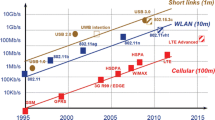Abstract
This article discusses modern techniques of implementation of a wideband digital modulator in an FPGA kit for use in electrical engineering communications laboratory. Previous configurations proposed in literature present limitations, as lack of details about the methods used in the algorithm developed and test procedures. Those key details can help researchers to develop this modulator more effectively. From technical point of view, previous works were also implemented for small bandwidth output signals. The proposed digital modulator has low cost and can generate signals based on several modulation schemes with various output roll-off filters. This proposed kit allows researchers to change digital signal characteristics through dip-switches, customizing the modulated signal. Advanced techniques such as parallelism of processes and fast access to look up tables using an FPGA were used to achieve the desired objective, and are detailed in the article. Besides this implementation, this article also shows test procedures to validate the performance of digital modulators using lab test equipment. Those procedures were used to validate the FPGA modulator developed. The paper shows how researchers can analyze the performance of digitally modulated output signals using an Oscilloscope, a Spectrum Analyzer, and a Vector Signal Analyzer. Features such as symbol rate, modulation constellation, roll-off output filter, and EVM are covered.




















Similar content being viewed by others
Abbreviations
- 4-PSK:
-
4-Phase shift keying
- 4-QAM:
-
4-Quadrature amplitude modulation
- 5G:
-
5th Generation mobile communication
- 8-PSK:
-
8-Phase shift keying
- 16-PSK:
-
16-Phase shift keying
- 16-QAM:
-
16-Quadrature amplitude modulation
- AD:
-
Analog to digital
- ADC:
-
Analog to digital converter
- B-ASK:
-
Binary amplitude shift keying
- B-FSK:
-
Binary frequency shift keying
- B-PSK:
-
Binary phase shift keying
- DA:
-
Digital to analog
- DAC:
-
Digital to analog converter
- DSP:
-
Digital signal processing
- EVM:
-
Error vector magnitude
- FPGA:
-
Field programmable gate array
- I:
-
In-phase component
- IC:
-
Integrated circuit
- ISI:
-
Inter-symbol interference
- LUT:
-
Look-up table
- MER:
-
Modulation error ratio
- PN:
-
Pseudo-noise
- Q:
-
Quadrature component
- QPSK:
-
Quadrature phase shift keying
- RO:
-
Roll-off
- SNR:
-
Signal to noise ratio
References
Proakis, J. G. (2002). Digital communications (5th ed., pp. 1–16). New York: McGraw Hill.
Altera. (1995). CPLDs vs. FPGAs—comparing-high capacity programmable logic. Altera Corporation, Tech. Rep.
Kiray, V., Demir, S., Zhaparov, M. (2013). Improving digital electronics education with FPGA technology, PBL and micro learning methods. In Proceedings of IEEE international conference on teaching, assessment and learning for engineering (TALE), Kuta, Indonesia, pp. 445–448.
Hamblen, J. O. (1996). Using VHDL based modeling, synthesis, and simulation in an introductory computer architecture laboratory. International Journal of Electrical Engineering and Education, 33, 251–260.
Figueiredo, F. A. P., Pereira, O. R., Torquato, A. F., et al. (2015). An efficient time-domain frequency shifter hardware architecture for 4G systems. Journal of Microwaves, Optoeletronics and Eletromagnetic Applications, 14, 205–207.
Trost, A., & Zemva, A. (2012). Teaching design of video processing circuits. International Journal of Electrical Engineering Education, 49, 170–179.
Wang, Y., Negri, L. H., Kalinowski, H. J., et al. (2014). Hardware embedded fiber sensor interrogation system using intensive digital signal processing. Journal of Microwaves, Optoeletronics and Eletromagnetic Applications, 13, 139–155.
Gomez, A. A., Menon, A. R., Aparna, V. G., et al. (2016). FPGA implementation of QAM. International Journal of Industrial Electronics and Electrical Engineering, 4, 77–79.
Sahoo, S. K., Begum, M. A. A., & Kalyan, G. (2015). Design and implementation of QAM architecture on FPGA for Wimax applications. International Journal of Scientific, Engineering and Technological Research, 4, 2625–2628.
Erdogan, C., Myderrizi, I., & Minaei, S. (2012). FPGA implementation of BASK-BFSK-BPSK digital modulators [testing ourselves]. IEEE Antennas and Propagations Magazine, 2, 262–269.
Lu, Y., Ahn, I. S., Gaught, A. (2013). Design and verification of a low-cost reconfigurable 16-QAM system. In IEEE international conference on electro-information technology, Rapid City, USA. https://doi.org/10.1109/EIT.2013.6632660.
Linn, Y. (2012). An ultra low cost wireless communications laboratory for education and research. IEEE Transactions on Education, 55(2), 169–179.
Lathi, B. P. (2000). Signal processing and linear systems (pp. 232–287). Oxford: Oxford University.
Donzellini, G., & Ponta, D. (2016). Digital design laboratory. In Biennial baltic electronics conference, Tallinn, Estonia, pp. 67–70.
Somanathan, A., Bhan, D., Salunkhe, N. et al. (2014). Implementation and analysis of a FPGA-programmable SOC interface towards mixed-signal educational platforms. In International conference on circuits, systems, communication and information technology applications, Mumbai, India, pp. 99–104.
Mitra, S. K. (2004). Digital signal processing: A computer-based approach (pp. 423–510). New York: Mcgraw-Hill.
Mathworks. (2011). Matlab version 11.
Brich, T., Novacek, K., Khateb, A. (2006). The digital signal processing using FPGA. In International spring seminar on electronics technology, St. Marienthal, Germany, pp. 322–324.
Altera. (2013). DE2-115 user manual.
Altera. (2016). Cyclone IV device handbook, vol. 1.
Keysight Technologies. (2017). Vector signal analyzer basics, application notes.
McKinley, M. D. (2004). EVM calculation for broadband modulated signals. In ARFTG microwave measurements conference, Orlando, USA, pp. 45–52.
Acknowledgements
The authors would like to thank PPEE-UFJF and FAPEMIG. This study was financed in part by the Coordenacao de Aperfeicoamento de Pessoal de Nivel Superior - Brasil (CAPES) - Finance Code 001.
Author information
Authors and Affiliations
Corresponding author
Additional information
Publisher's Note
Springer Nature remains neutral with regard to jurisdictional claims in published maps and institutional affiliations.
Rights and permissions
About this article
Cite this article
Corrêa, L.A., de A. Oliveira, I., de Medeiros, A.A.M. et al. Wideband FPGA-based digital modulator programming and practical validation techniques. Analog Integr Circ Sig Process 106, 577–592 (2021). https://doi.org/10.1007/s10470-020-01673-2
Received:
Revised:
Accepted:
Published:
Issue Date:
DOI: https://doi.org/10.1007/s10470-020-01673-2




